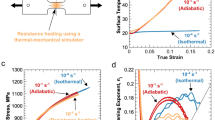Abstract
The strength differential (SD) has been measured as a function of temperature in a fully hardened 0.2C, 6 Ni steel, quenched and then tempered at 250°C. It is found appropriate to express the results in terms of the intercept flow stresses as extrapolated back to zero plastic strain. The corresponding SD increases significantly with decreasing temperature below the ambient, and the data are well fitted by separating the SD into an athermal component (~3 pct) and a thermally activated component (up to ~15 pct at the liquid-nitrogen temperature). The latter type of contribution is thought to arise from a dilatation which occurs during the activation process for dislocation motion and which causes an increase in the activation energy under compressive loading and a decrease under tensile loading. The parameters obtained via this treatment are consistent with a double-kink Peierlsbarrier mechanism of plastic flow at low temperatures.
Similar content being viewed by others
References
W. C. Leslie and R.J. Sober:Trans. ASM, 1967, vol.60, p.459.
D. Kalish and M. Cohen:Trans. ASM, 1969, vol. 62, p. 353.
J. P. Hirth and M. Cohen:Met. Trans., 1970, vol. 1, p. 3.
R. Chait:Met. Trans., 1972, vol. 3, p. 365.
G. C. Rauch and W.C Leslie:Met. Trans., 1972, vol. 3, p. 373.
D. C. Drucker:Met. Trans., 1973, vol. 4, p. 667.
C. A. Pampillo, L. A. Davis and J.C. M.Li:Scr. Met., 1972, vol. 6, p. .765.
R. J. Olson and G. S. Ansell:Trans. ASM, 1969, vol. 62, p. 711.
R. Chait:Scr. Met, 1973, vol. 7, p. 351.
W. C. Leslie:Scr. Met., 1972, vol. 6, p. 1145.
H. Conrad and H. Wiedersich:Acta Met, 1960, vol. 8, p. 128.
J. C. M. Li:Dislocation Dynamics, p. 87, McGraw-Hill Book Co., N. Y., 1968.
J. P. Hirth and W.D. Nix:Phys. Status Solidi, 1969, vol. 35, p. 177.
J. Lothe and J. P. Hirth:Phys. Rev., 1959, vol. 115, p. 543.
J. P. Hirth:Inelastic Behavior of Solids, p. 281, McGraw-Hill Book Co., N.Y., 1970.
J. P. Hirth and J. Lothe:Theory of Dislocations, McGraw-Hill Book Co., N.Y., 1968.
P. C. Gehlen, J. P. Hirth, R. G. Hoagland, M. F. Kanninen:J. Appl. Phys., 1972, vol. 43, p. 3921.
F. R. N. Nabarro:Theory of Crystal Dislocations, p. 165, Oxford University Press, Oxford, 1967.
Author information
Authors and Affiliations
Additional information
This paper is based on a doctoral thesis presented in August 1972 by F. B. Fletcher to the Department of Metallurgy and Materials Science at the Massachusetts Institute of Technology.
Rights and permissions
About this article
Cite this article
Fletcher, F.B., Cohen, M. & Hirth, J.P. Temperature dependence of the strength-differential effect in hardened steels. Metall Trans 5, 905–908 (1974). https://doi.org/10.1007/BF02643146
Received:
Published:
Issue Date:
DOI: https://doi.org/10.1007/BF02643146




